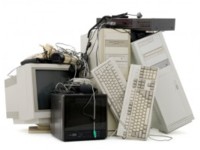E-Waste Crisis Being Mitigated by Electronics Recycling and Reuse
 As the adoption of consumer electronics, mobile phones, and computer equipment continues to increase around the world, the business and environmental challenges associated with electronic device disposition at end-of-life (EOL) grow greater and greater.
As the adoption of consumer electronics, mobile phones, and computer equipment continues to increase around the world, the business and environmental challenges associated with electronic device disposition at end-of-life (EOL) grow greater and greater. According to a new report from Pike Research, as devices become obsolete and are replaced, the total volume and weight of EOL electronics, which is known as e-scrap, will more than double in the next 15 years, rising from 676 million cubic feet (and 6.0 million tons) in 2010 to 1,465 million cubic feet (and 14.9 million tons) by 2025.
This trend will place increasing pressure on industry players, governments, and advocacy groups to find new ways to expand electronics recycling and reuse. E-scrap that is not recycled, reused, or stored becomes e-waste and is buried, incinerated, or dumped, representing a significant environmental hazard.
During the same forecast period, Pike Research anticipates that the electronics recycling movement will make strong progress, and the cleantech market intelligence firm forecasts that electronics recycling and reuse will rise from 122 million cubic feet (and 1.1 million tons) per year in 2010 to 789 million cubic feet (and 7.9 million tons) annually by 2025.
By the early 2020s, the firm expects that recycling and reuse activity will surpass the annual volume and weight of electronic devices that become e-waste, and thus will play a large part in mitigating the e-waste crisis.
However, these promising trends will still not be enough to solve the entire problem, as Pike Research anticipates that the total volume of e-waste in landfills will continueincreasing throughout the period.
“Electronics recycling and reuse is expanding at a significant rate,” says industry analyst Bob Boggio.
“The growth in responsible disposition of obsolete electronics is being driven both by environmental legislation around the world as well as the sustainability and corporate social responsibility (CSR) programs of leading electronics manufacturers and service providers.”
However, Boggio adds that unwanted electronic equipment is still easily and inexpensively sent to landfill burial rather than being directed toward reuse or recycling. Trans-boundary shipments of e-waste from developed countries to developing countries continue, and the informal recovery of components and materials in developing countries remain a concern for human health and the environment.
Boggio states that the gap may be narrowed in the coming years if national and regional governments modify their legislative mandates to close perceived loopholes and increase e-scrap diversion rates.
Pike Research’s report, “Electronics Recycling and E-Waste Issues”, provides a detailed analysis of e-scrap issues facing the electronics industry over the coming years, including an assessment of market and economic factors, legislative issues, environmental concerns, and the strategies of key industry players.
The study includes market forecasts through 2025 for unit sales of electronics by category, along with volume and weight of total e-scrap generated as well as the ultimate disposition through recycling, reuse, storage, and e-waste.
Also included are detailed interview responses from state environmental management agencies, OEMs and service providers, and e-waste processing companies. An Executive Summary of the report is available for free download on the firm’s website.
You can return to the main Market News page, or press the Back button on your browser.

